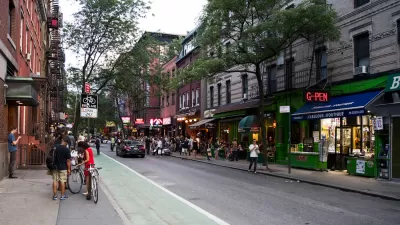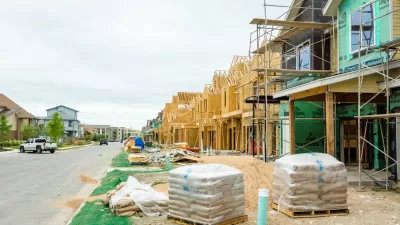Smart Growth

USDOT Releases Climate Strategies Playbook
The USDOT's new Climate Strategies that Work Playbook provides detailed information concerning benefits and implementation requirements for 27 transportation-related emission reduction strategies.

Book Review: Combining Sustainability and Smart Growth
A review of The Sustainable Urban Design Handbook, by architects Nico Larco and Kaarin Knudson.

Analyzing Accessibility Disparities
With better planning we can reduce disparities between drivers and non-drivers in their ability to access services and jobs, improving fairness and economic opportunities for disadvantaged groups.

Maine Law Promotes Smart Growth
New state legislation encourages cities to plan around ‘smart growth’ principles to preserve farmland and open space, and use infill development to build more housing.

A Better Understanding of Smart Growth Benefits
Smart Growth creates compact, multimodal communities where residents consume less land, drive less, and rely more on non-auto modes. Planners have important stories to tell about the benefits of Smart Growth.

Calculating Vehicle Travel Reduction Benefits
The Rocky Mountain Institute's new Smarter MODES Calculator quantifies economic, social and environmental benefits provided by shifts from automobile travel to more resource-efficient modes. This includes benefits that are often overlooked or undervalued in conventional planning.

Upzoning Affordability Impacts: The Latest Research
There are new controversies concerning how upzoning affects housing supply and affordability, and new research to help planners understand these issues.

All We Want for the Holidays is…
Here are a dozen timely gift ideas for creating better communities.

Smart Growth Plan Hopes to Rein in Sprawl in Walla Walla
The Washington city reformed its zoning code to support more multifamily development and a diversity of housing types to meet the needs of its growing population.

Initiative Brings Capacity Building to Booming Rural Towns
A research and capacity building initiative based at Utah State University seeks to help fast-growing tourist meccas in the West plan for smart growth.

Why Nevada Needs Sustainable, Smart Growth
Sprawling cities like Las Vegas must rein in unchecked growth and promote infill development and more sustainable transportation modes.

Urban Villages for the Proletariat
Compact, walkable urban villages benefit working families and organized labor by creating jobs, improving household affordability, reducing commute duration, improving economic opportunities, and creating cleaner, healthier communities.

What Is Smart Growth?
Smart growth describes an approach to planning and development that prioritizes compact built environments, designed for benefits to the economy and the environment.

Smart Growth Loves Heatmaps
Smart growth can provide many important benefits that are easy to see using informative and beautiful heatmaps—our complex world as viewed by all-knowing gods.

Getting to Work: New Commute Duration Heatmaps
The Mineta Transportation Institute's new interactive website produces heatmaps that illustrate commute duration—the number of minutes that workers spend traveling to their jobs—plus related information, for most U.S. communities.

Clean Vehicles Versus Vehicle Travel Reductions: Better Transportation Emission Reduction Planning
There are many possible ways to reduce transportation emissions, some of which provide large co-benefits. Unfortunately, current evaluation practices tend to overlook some of the best. Lets examine why.

To Save the Climate: Driving Habits Must Change
Even with ambitious electric Vehicle adoption, the United States must reduce vehicle miles traveled by 20 percent before the end of the decade to limit warming to 1.5°C, according to new research by the Rocky Mountain Institute.

What Is Sprawl?
Sprawl is one of the most common terms used to describe built environments in the United States and the world. It can be applied to urban, suburban, and exurban settings, and it's almost never a compliment.

The Housing Supply Debate: Evaluating the Evidence
Let's rely on science, not ideology and propaganda, when planning solutions to urban unaffordability. Look for credible evidence in the peer-reviewed publications referenced here.

The Housing Affordability Recipe
Smart policies can ensure that low- and moderate-income households can find suitable housing in good neighborhoods where transportation costs are low. The research is clear: upzoning works.
Pagination
Urban Design for Planners 1: Software Tools
This six-course series explores essential urban design concepts using open source software and equips planners with the tools they need to participate fully in the urban design process.
Planning for Universal Design
Learn the tools for implementing Universal Design in planning regulations.
Heyer Gruel & Associates PA
JM Goldson LLC
Custer County Colorado
City of Camden Redevelopment Agency
City of Astoria
Transportation Research & Education Center (TREC) at Portland State University
Jefferson Parish Government
Camden Redevelopment Agency
City of Claremont


































